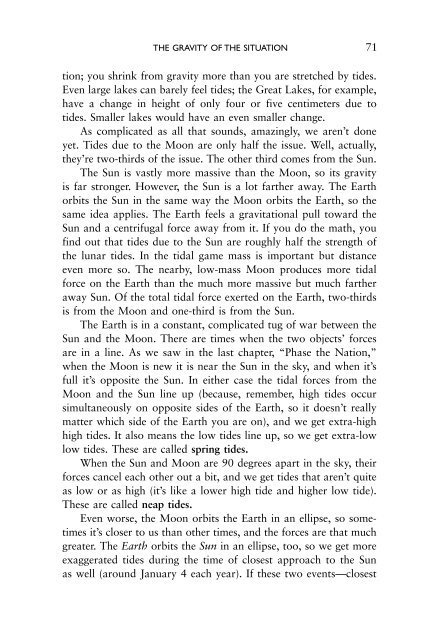Bad Astronomy: Misconceptions and Misuses Revealed, from ...
Bad Astronomy: Misconceptions and Misuses Revealed, from ...
Bad Astronomy: Misconceptions and Misuses Revealed, from ...
You also want an ePaper? Increase the reach of your titles
YUMPU automatically turns print PDFs into web optimized ePapers that Google loves.
THE GRAVITY OF THE SITUATION 71<br />
tion; you shrink <strong>from</strong> gravity more than you are stretched by tides.<br />
Even large lakes can barely feel tides; the Great Lakes, for example,<br />
have a change in height of only four or five centimeters due to<br />
tides. Smaller lakes would have an even smaller change.<br />
As complicated as all that sounds, amazingly, we aren’t done<br />
yet. Tides due to the Moon are only half the issue. Well, actually,<br />
they’re two-thirds of the issue. The other third comes <strong>from</strong> the Sun.<br />
The Sun is vastly more massive than the Moon, so its gravity<br />
is far stronger. However, the Sun is a lot farther away. The Earth<br />
orbits the Sun in the same way the Moon orbits the Earth, so the<br />
same idea applies. The Earth feels a gravitational pull toward the<br />
Sun <strong>and</strong> a centrifugal force away <strong>from</strong> it. If you do the math, you<br />
find out that tides due to the Sun are roughly half the strength of<br />
the lunar tides. In the tidal game mass is important but distance<br />
even more so. The nearby, low-mass Moon produces more tidal<br />
force on the Earth than the much more massive but much farther<br />
away Sun. Of the total tidal force exerted on the Earth, two-thirds<br />
is <strong>from</strong> the Moon <strong>and</strong> one-third is <strong>from</strong> the Sun.<br />
The Earth is in a constant, complicated tug of war between the<br />
Sun <strong>and</strong> the Moon. There are times when the two objects’ forces<br />
are in a line. As we saw in the last chapter, “Phase the Nation,”<br />
when the Moon is new it is near the Sun in the sky, <strong>and</strong> when it’s<br />
full it’s opposite the Sun. In either case the tidal forces <strong>from</strong> the<br />
Moon <strong>and</strong> the Sun line up (because, remember, high tides occur<br />
simultaneously on opposite sides of the Earth, so it doesn’t really<br />
matter which side of the Earth you are on), <strong>and</strong> we get extra-high<br />
high tides. It also means the low tides line up, so we get extra-low<br />
low tides. These are called spring tides.<br />
When the Sun <strong>and</strong> Moon are 90 degrees apart in the sky, their<br />
forces cancel each other out a bit, <strong>and</strong> we get tides that aren’t quite<br />
as low or as high (it’s like a lower high tide <strong>and</strong> higher low tide).<br />
These are called neap tides.<br />
Even worse, the Moon orbits the Earth in an ellipse, so sometimes<br />
it’s closer to us than other times, <strong>and</strong> the forces are that much<br />
greater. The Earth orbits the Sun in an ellipse, too, so we get more<br />
exaggerated tides during the time of closest approach to the Sun<br />
as well (around January 4 each year). If these two events—closest
















